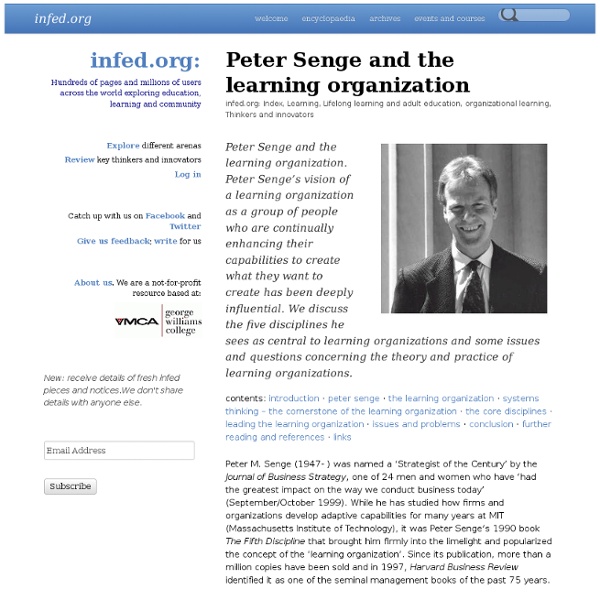What is BYOD
Main » TERM » B » By Vangie Beal BYOD is short for bring your own device.
Building a Learning Organization
The Idea in Brief As we all know, to stay ahead of competitors, companies must constantly enhance the way they do business. But more performance-improvement programs fail than succeed. That’s because many managers don’t realize that sustainable improvement requires a commitment to learning.
Systems Thinking Resources - The Donella Meadows Institute
Concepts and Frameworks The Five Learning Disciplines Developed by renowned systems thinker Peter Senge, these five disciplines each enhance the ability of a person or organization to use learning effectively. Leveraged together, they contribute heavily to the success of learning organizations, defined by Senge as, “…organizations where people continually expand their capacity to create the results they truly desire, where new and expansive patterns of thinking are nurtured, where collective aspiration is set free, and where people are continually learning to see the whole together.” The five learning disciplines are Personal MasteryMental ModelsShared VisionTeam LearningSystems Thinking
A summary of Senge's famous book- The Fifth Discipline - decision making
Prof.Lakshman Started The Discussion: Peter Senge's The Fifth Discipline is divided into five parts. Part I is devoted to laying out the argument that we are the creators of our own reality, i.e., that the solutions to the problems that we face are at our reach, that we have the power to control our destinies.
Envisioning the Future of Education Technology #edtech #eLearning
“Education lies at a peculiar crossroad in society. On one hand it has the responsibility of anticipating real-life skills by preparing us for an increasingly complex world – but education methodologies can only be formalized after practices have been defined. This dichotomy is particularly aggravated when it comes to technology, where fast-paced innovation and perpetual change is the only constant.
Dan Pink: How Teachers Can Sell Love of Learning to Students
By Jennie Rose In his new book To Sell is Human, author Daniel Pink reports that education is one of the fastest growing job categories in the country. And with this growth comes the opportunity to change the way educators envision their roles and their classrooms. Guided by findings in educational research and neuroscience, the emphasis on cognitive skills like computation and memorization is evolving to include less tangible, non-cognitive skills, like collaboration and improvisation.
10 Useful Ideas on Systems Thinking - Futurist.com: Futurist Speaker Glen Hiemstra
By Richard Wilkinson, 2001 “Real life is lived in a complex world system where all the subsystems overlap and affect each other.” At the heart of systems thinking is the principle of interconnectedness. I compiled the following list to make this core idea translatable to daily life. The ideas presented here are not meant to be the final word on the subject of systems thinking. Indeed, one author listed no less than 28 ideas(1), a couple of which found their way here, too.
The Fifth Discipline
The Fifth Discipline: The Art and Practice of the Learning Organization (Senge 1990) is a book by Peter Senge (a senior lecturer at MIT) focusing on group problem solving using the systems thinking method in order to convert companies into learning organizations. The five disciplines represent approaches (theories and methods) for developing three core learning capabilities: fostering aspiration, developing reflective conversation, and understanding complexity. The Five Disciplines[edit] The five disciplines of what the book refers to as a "learning organization" discussed in the book are: "Personal mastery is a discipline of continually clarifying and deepening our personal vision, of focusing our energies, of developing patience, and of seeing reality objectively
Are kids really motivated by technology?
As a guy who delivers two-day #edtech workshops during my breaks from full-time classroom teaching, I’m often asked the same questions again and again: How can teachers use technology to motivate students? What digital tools do kids like best? My answer often catches participants by surprise: You can’t motivate students with technology because technology alone isn’t motivating. Worse yet, students are almost always ambivalent toward digital tools. While you may be completely jazzed by the interactive whiteboard in your classroom or the wiki that you just whipped up, your kids could probably care less. Need proof?
Make Learning Matter: Become a Learning Organization
Organizations with the best chance to succeed and thrive in the future are learning organizations. In his landmark book, The Fifth Discipline: The Art and Practice of the Learning Organization (Compare Prices) , Peter Senge defined the learning organization. He said they were “organizations where people continually expand their capacity to create the results they truly desire, where new and expansive patterns of thinking are nurtured, where collective aspiration is set free, and where people are continually learning how to learn together.” Senge frames our understanding of the learning organization with an ensemble of disciplines which he believes must converge to form a learning organization.
Systems thinking primer printable version
THE LANGUAGE OF SYSTEMS THINKING Linear Thinking Focuses on the immediate cause and effect of events. Cause and effect are assumed to occur together. Systems Thinking Focuses on the interrelationship and dynamics among system components. Cause and effect are separated in time and space. Detail Complexity Characterized by many variables and complex arrangements. Cause and effect occur together.
5 Learning Disciplines
In 1990, Peter Senge published "The Fifth Discipline" (later followed by "The Fifth Discipline Fieldbook: Strategies and Tools for Building a Learning Organization" in 1994). His books pulled together his extensive research into what different organisations do to build learning capacity – and why some organisations use learning better than others. Senge codified these practices into what he called 'The 5 Learning Disciplines' as well as coming up with the concept-label of 'learning organisations'.



